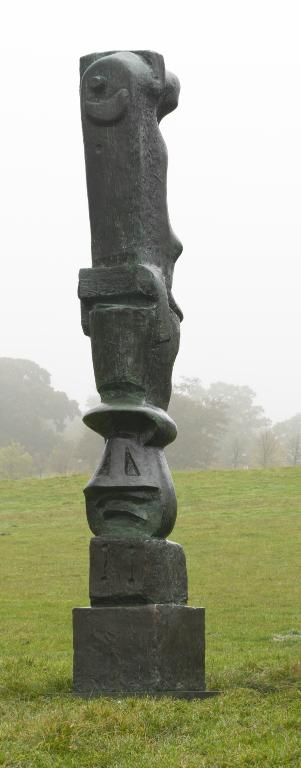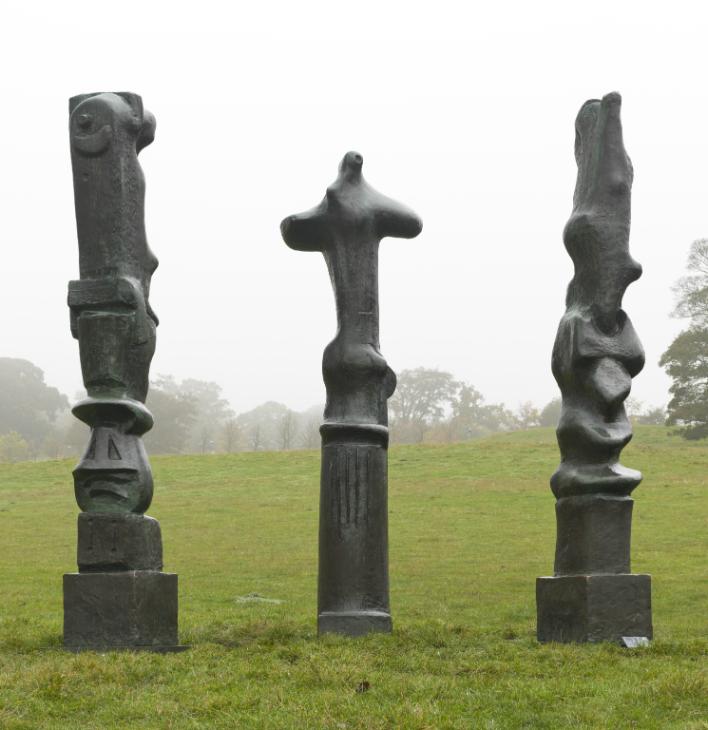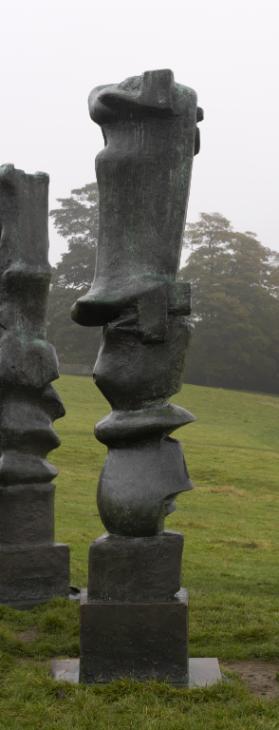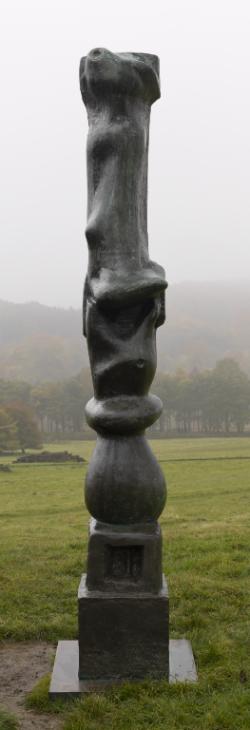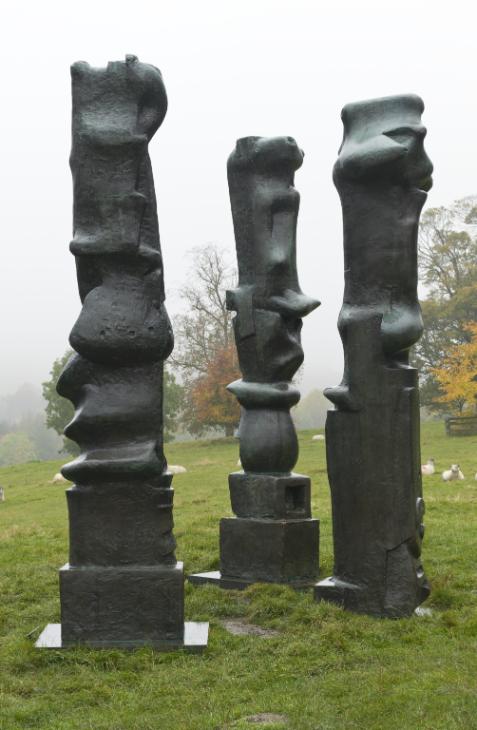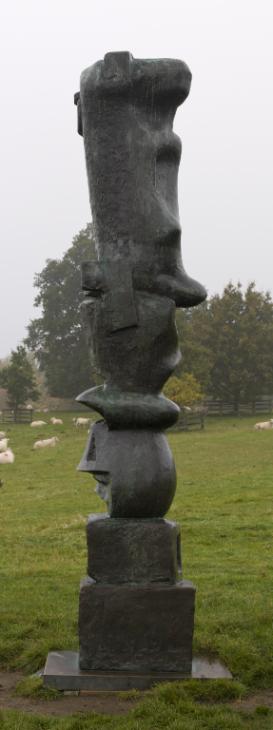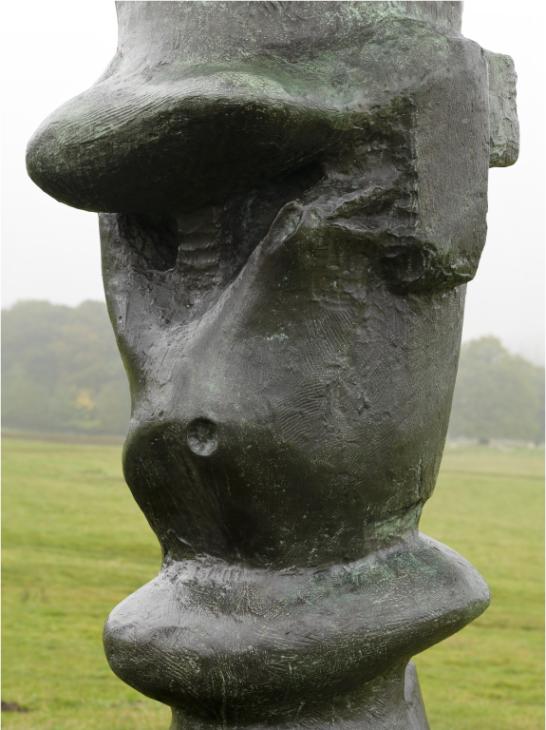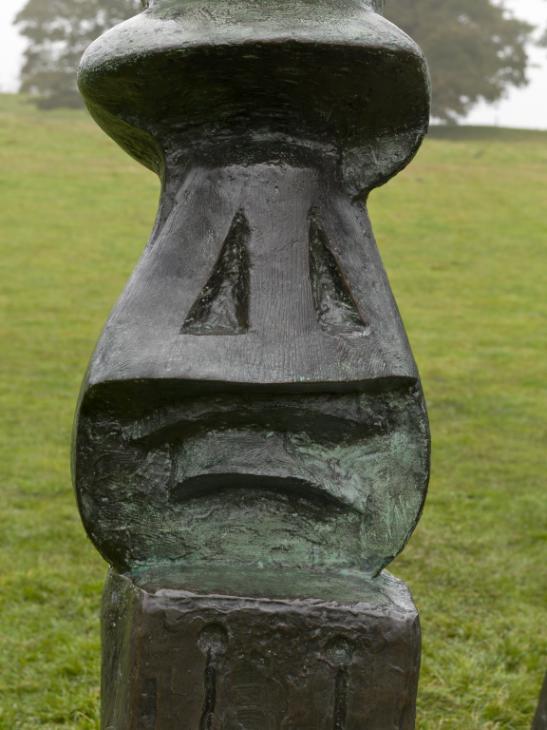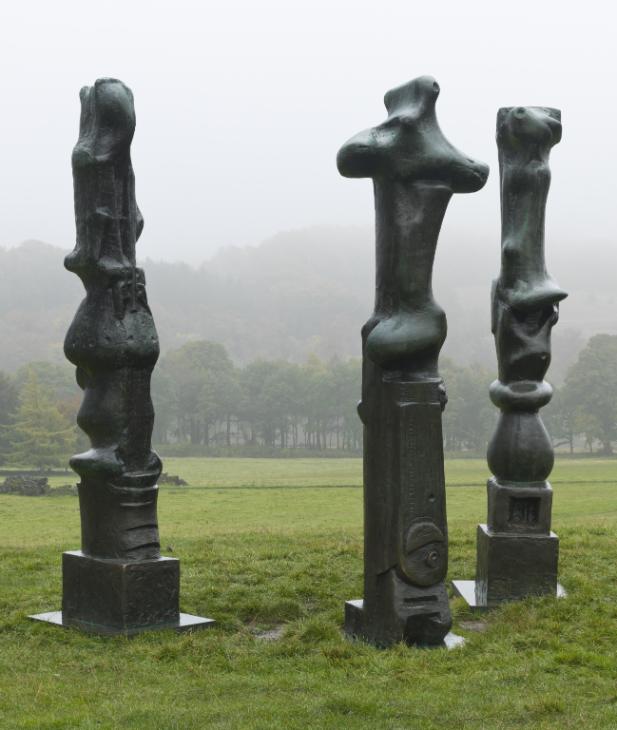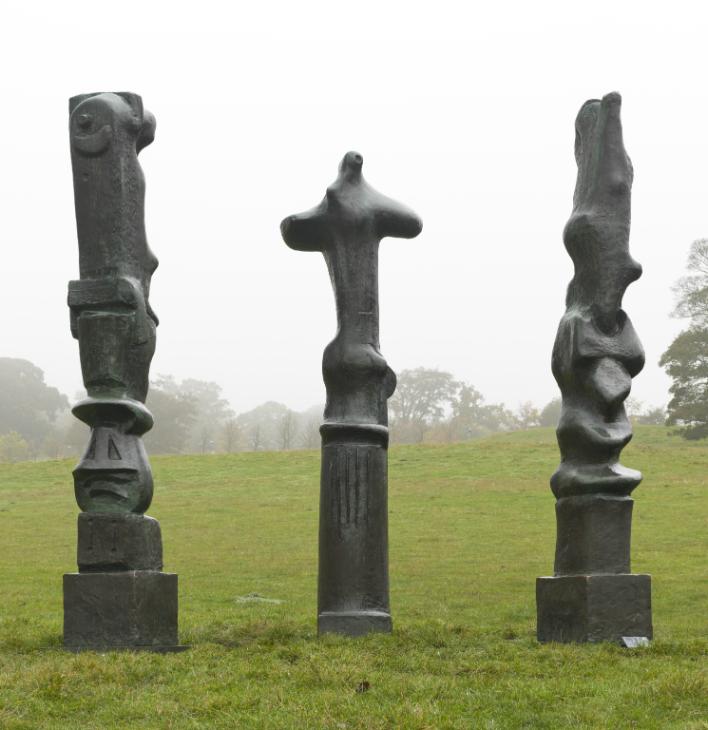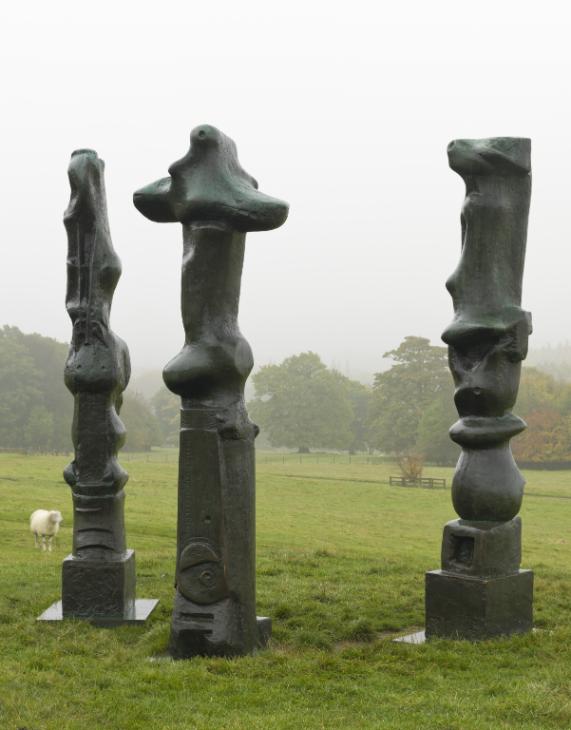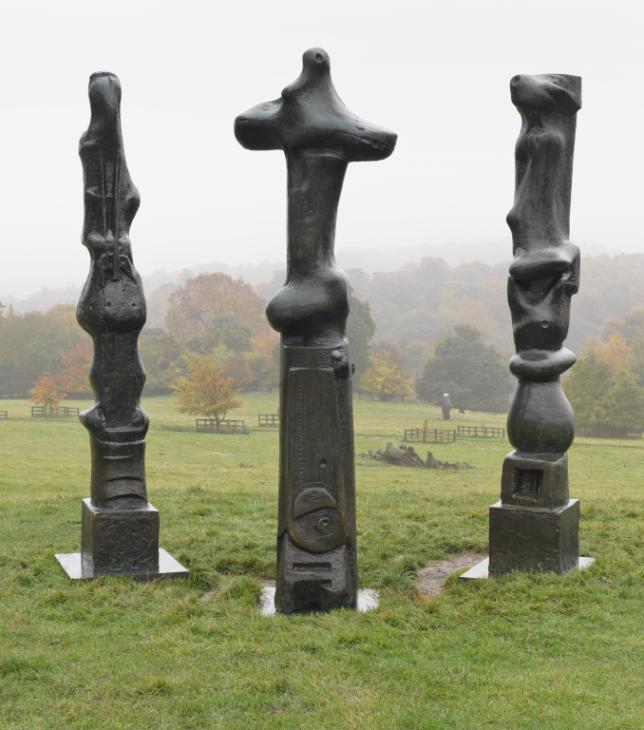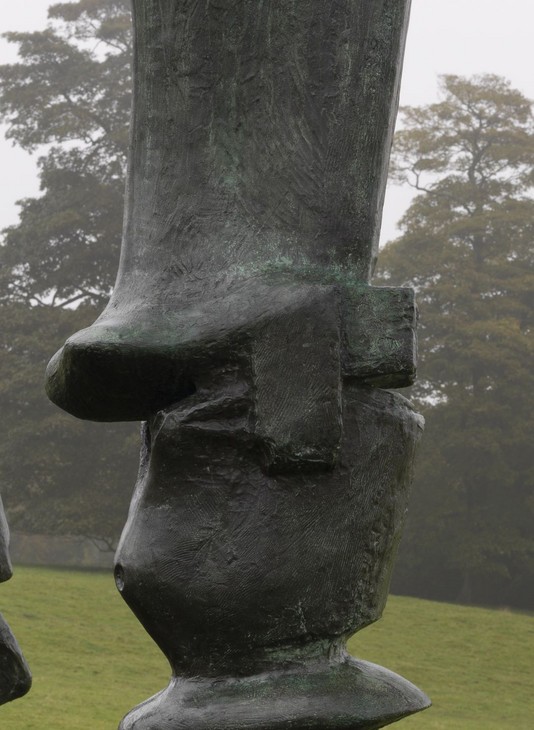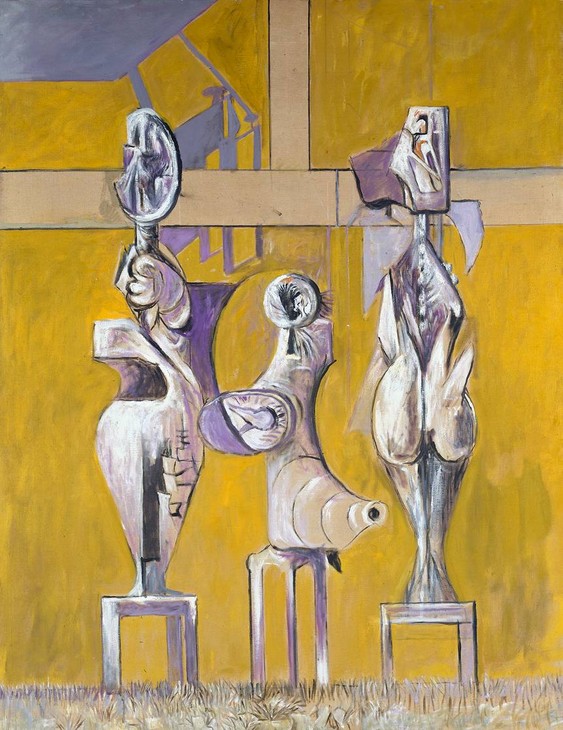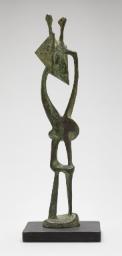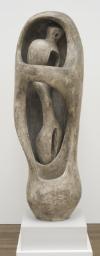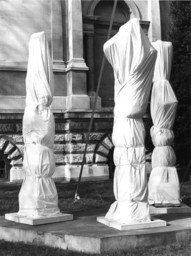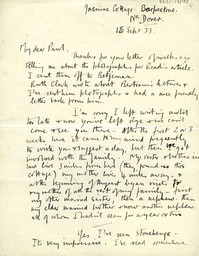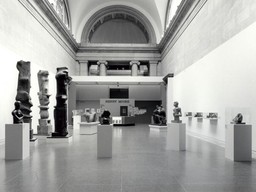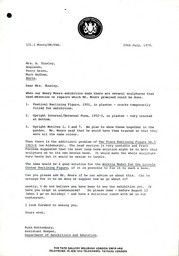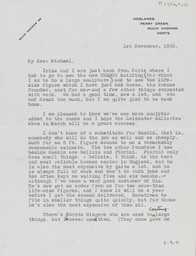Henry Moore OM, CH Upright Motive No.2 1955-6, cast c.1958-62
Image 1 of 14
-
 Henry Moore OM, CH, Upright Motive No.2 1955-6, cast c.1958-62© The Henry Moore Foundation. All Rights Reserved© The Henry Moore Foundation. All Rights Reserved
Henry Moore OM, CH, Upright Motive No.2 1955-6, cast c.1958-62© The Henry Moore Foundation. All Rights Reserved© The Henry Moore Foundation. All Rights Reserved -
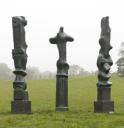 Henry Moore OM, CH, Upright Motive No.2 1955-6, cast c.1958-62© The Henry Moore Foundation. All Rights Reserved© The Henry Moore Foundation. All Rights Reserved
Henry Moore OM, CH, Upright Motive No.2 1955-6, cast c.1958-62© The Henry Moore Foundation. All Rights Reserved© The Henry Moore Foundation. All Rights Reserved -
 Henry Moore OM, CH, Upright Motive No.2 1955-6, cast c.1958-62© The Henry Moore Foundation. All Rights Reserved© The Henry Moore Foundation. All Rights Reserved
Henry Moore OM, CH, Upright Motive No.2 1955-6, cast c.1958-62© The Henry Moore Foundation. All Rights Reserved© The Henry Moore Foundation. All Rights Reserved -
 Henry Moore OM, CH, Upright Motive No.2 1955-6, cast c.1958-62© The Henry Moore Foundation. All Rights Reserved© The Henry Moore Foundation. All Rights Reserved
Henry Moore OM, CH, Upright Motive No.2 1955-6, cast c.1958-62© The Henry Moore Foundation. All Rights Reserved© The Henry Moore Foundation. All Rights Reserved -
 Henry Moore OM, CH, Upright Motive No.2 1955-6, cast c.1958-62© The Henry Moore Foundation. All Rights Reserved© The Henry Moore Foundation. All Rights Reserved
Henry Moore OM, CH, Upright Motive No.2 1955-6, cast c.1958-62© The Henry Moore Foundation. All Rights Reserved© The Henry Moore Foundation. All Rights Reserved -
 Henry Moore OM, CH, Upright Motive No.2 1955-6, cast c.1958-62© The Henry Moore Foundation. All Rights Reserved© The Henry Moore Foundation. All Rights Reserved
Henry Moore OM, CH, Upright Motive No.2 1955-6, cast c.1958-62© The Henry Moore Foundation. All Rights Reserved© The Henry Moore Foundation. All Rights Reserved -
 Henry Moore OM, CH, Upright Motive No.2 1955-6, cast c.1958-62© The Henry Moore Foundation. All Rights Reserved© The Henry Moore Foundation. All Rights Reserved
Henry Moore OM, CH, Upright Motive No.2 1955-6, cast c.1958-62© The Henry Moore Foundation. All Rights Reserved© The Henry Moore Foundation. All Rights Reserved -
 Henry Moore OM, CH, Upright Motive No.2 1955-6, cast c.1958-62© The Henry Moore Foundation. All Rights Reserved© The Henry Moore Foundation. All Rights Reserved
Henry Moore OM, CH, Upright Motive No.2 1955-6, cast c.1958-62© The Henry Moore Foundation. All Rights Reserved© The Henry Moore Foundation. All Rights Reserved -
 Henry Moore OM, CH, Upright Motive No.2 1955-6, cast c.1958-62© The Henry Moore Foundation. All Rights Reserved© The Henry Moore Foundation. All Rights Reserved
Henry Moore OM, CH, Upright Motive No.2 1955-6, cast c.1958-62© The Henry Moore Foundation. All Rights Reserved© The Henry Moore Foundation. All Rights Reserved -
 Henry Moore OM, CH, Upright Motive No.2 1955-6, cast c.1958-62© The Henry Moore Foundation. All Rights Reserved© The Henry Moore Foundation. All Rights Reserved
Henry Moore OM, CH, Upright Motive No.2 1955-6, cast c.1958-62© The Henry Moore Foundation. All Rights Reserved© The Henry Moore Foundation. All Rights Reserved -
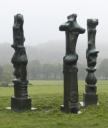 Henry Moore OM, CH, Upright Motive No.2 1955-6, cast c.1958-62© The Henry Moore Foundation. All Rights Reserved© The Henry Moore Foundation. All Rights Reserved
Henry Moore OM, CH, Upright Motive No.2 1955-6, cast c.1958-62© The Henry Moore Foundation. All Rights Reserved© The Henry Moore Foundation. All Rights Reserved -
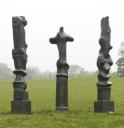 Henry Moore OM, CH, Upright Motive No.2 1955-6, cast c.1958-62© The Henry Moore Foundation. All Rights Reserved© The Henry Moore Foundation. All Rights Reserved
Henry Moore OM, CH, Upright Motive No.2 1955-6, cast c.1958-62© The Henry Moore Foundation. All Rights Reserved© The Henry Moore Foundation. All Rights Reserved -
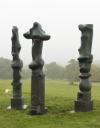 Henry Moore OM, CH, Upright Motive No.2 1955-6, cast c.1958-62© The Henry Moore Foundation. All Rights Reserved© The Henry Moore Foundation. All Rights Reserved
Henry Moore OM, CH, Upright Motive No.2 1955-6, cast c.1958-62© The Henry Moore Foundation. All Rights Reserved© The Henry Moore Foundation. All Rights Reserved -
 Henry Moore OM, CH, Upright Motive No.2 1955-6, cast c.1958-62© The Henry Moore Foundation. All Rights Reserved© The Henry Moore Foundation. All Rights Reserved
Henry Moore OM, CH, Upright Motive No.2 1955-6, cast c.1958-62© The Henry Moore Foundation. All Rights Reserved© The Henry Moore Foundation. All Rights Reserved
© The Henry Moore Foundation. All Rights Reserved
Henry Moore OM, CH,
Upright Motive No.2
1955-6, cast c.1958-62
© The Henry Moore Foundation. All Rights Reserved
Upright Motive No.2 is one of a series of tall standing sculptures made by Moore between 1955 and 1956 that originated from ideas he had developed in response to architectural commissions. Its amorphous shapes and vertical orientation recall Moore’s earlier surrealist works and his interest in prehistoric and ancient Greek art.
Henry Moore OM, CH 1898–1986
Upright Motive No.2
1955–6, cast c.1958–62
Bronze
3353 x 768 x 972 mm
Presented by the artist 1978
In an edition of 5 plus 1 artist’s copy
T02275
Upright Motive No.2
1955–6, cast c.1958–62
Bronze
3353 x 768 x 972 mm
Presented by the artist 1978
In an edition of 5 plus 1 artist’s copy
T02275
Ownership history
Presented by the artist to Tate in 1978 as part of the Henry Moore Gift.
Exhibition history
1960–1
Henry Moore: An Exhibition of Sculpture from 1950–1960, Whitechapel Art Gallery, London, November 1960–January 1961, no.26.
1968
Henry Moore, Tate Gallery, London, July–September 1968, no.96.
1978
Henry Moore: 80th Birthday Exhibition, Cartwright Hall, Bradford, April–June 1978, no.8 (?another cast exhibited).
1978
The Henry Moore Gift, Tate Gallery, London, June–August 1978, no number.
1988
Henry Moore, Royal Academy of Arts, London, September–December 1988, no.135.
2013–14
Bacon / Moore: Flesh and Bone, Ashmolean Museum, Oxford, September 2013–January 2014.
References
1960
Henry Moore: An Exhibition of Sculpture from 1950–1960, exhibition catalogue, Whitechapel Art Gallery, London 1960 (?another cast reproduced no.26).
1960
Will Grohmann, The Art of Henry Moore, London 1960, pp.197–215.
1962
Henry Moore, exhibition catalogue, M. Knoedler and Co., New York 1962, reproduced pp.16–17.
1965
Herbert Read, Henry Moore: A Study of his Life and Work, London 1965, pp.203–8, reproduced pl.191.
1965
Alan Bowness (ed.), Henry Moore. Volume 3: Sculpture and Drawings 1955–64, 1965, revised edn, London 1986, no.379 (?another cast reproduced pls.4–5, 8).
1965
Anon., ‘Acquisitions of Works of Art by Museums and Galleries’, Burlington Magazine, June 1965 (another cast reproduced pp.337–45).
1965
Henry Moore, John Russell and A.M. Hammacher, Drie Staande Motieven, Otterlo 1965, reproduced.
1966
Philip James (ed.), Henry Moore on Sculpture, London 1966, pp.253–7, reproduced pl.110.
1968
David Sylvester, Henry Moore, exhibition catalogue, Tate Gallery, London 1968, p.127 (another cast reproduced pls.118, 130).
1968
John Hedgecoe (ed.), Henry Moore, London 1968, pp.245, 250.
1968
John Russell, Henry Moore, London 1968, pp.141–56 (?another cast reproduced pl.162).
1973
John Russell, Henry Moore, London 1973, pp.165–83.
1978
Henry Moore: 80th Birthday Exhibition, exhibition catalogue, Cartwright Hall, Bradford 1978, reproduced.
1978
The Henry Moore Gift, exhibition catalogue, Tate Gallery, London 1978, reproduced p.33.
1979
Alan G. Wilkinson, The Moore Collection in the Art Gallery of Ontario, Toronto 1979, p.139.
1981
[Richard Calvocoressi], ‘Upright Motive No.2’, The Tate Gallery 1978–80: Illustrated Catalogue of Acquisitions, London 1981, p.121.
1998
Margaret Garlake, New Art / New World: British Art in Postwar Society, New Haven and London 1998, pp.191–2.
2007
Julian Rea, ‘A Major Contribution to Public Sculpture in Britain: Patricia, Lady Gibberd (1926–2006), and the Harlow Sculpture Collection’, Sculpture Journal, vol.16, no.2, 2007, pp.89–91.
2007
Moore at Kew, exhibition catalogue, Royal Botanic Gardens, Kew 2007–8 (another cast reproduced pp.38–40).
2007
Jeremy Lewison, Henry Moore 1898–1986, Cologne 2007 (another cast reproduced p.70).
2008
Christa Lichtenstern, Henry Moore: Work-Theory-Impact, London 2008, pp.203–6 (another cast reproduced no.248).
2011
Anita Feldman and Malcolm Woodward, Henry Moore: Plasters, London 2011 (full-size plaster reproduced no.85).
2013
Richard Calvocoressi, Martin Harrison and Francis Warner, Bacon / Moore: Flesh and Bone, exhibition catalogue, Ashmolean Museum, Oxford 2013, reproduced.
Technique and condition
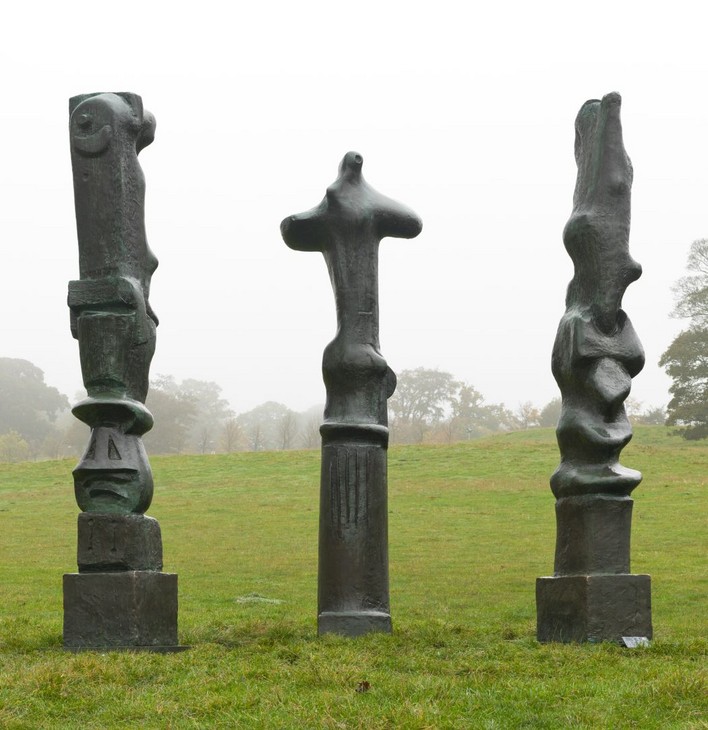
Upright Motive No.2 1955–6, cast c.1958–62, Upright Motive No.1: Glenkiln Cross 1955–6, cast 1958–60, and Upright Motive No.7 1955–6, cast c.1958–61
Tate
© The Henry Moore Foundation. All Rights Reserved
Fig.1
Upright Motive No.2 1955–6, cast c.1958–62, Upright Motive No.1: Glenkiln Cross 1955–6, cast 1958–60, and Upright Motive No.7 1955–6, cast c.1958–61
Tate
© The Henry Moore Foundation. All Rights Reserved
Moore would have made the original model for this sculpture by building up successive layers of plaster over a supportive armature, probably made of wood or metal. A particular feature of this sculpture is the use of protruding curved forms that Moore built up to contrast with deeply carved recesses (fig.2). Looking at the surface it is clear that Moore employed a range of different techniques to create specific textures and designs. For example there are roughly textured areas produced by adding wet plaster with a spatula, and fine striations possibly made with a serrated blade. These marks were reproduced in the bronze sculpture during the casting process. At the top of the sculpture Moore created designs with well-defined edges in high relief (fig.3).

Detail of Upright Motive No.2 1955–6, cast c.1958–62
Tate T02275
© The Henry Moore Foundation. All Rights Reserved
Fig.2
Detail of Upright Motive No.2 1955–6, cast c.1958–62
Tate T02275
© The Henry Moore Foundation. All Rights Reserved
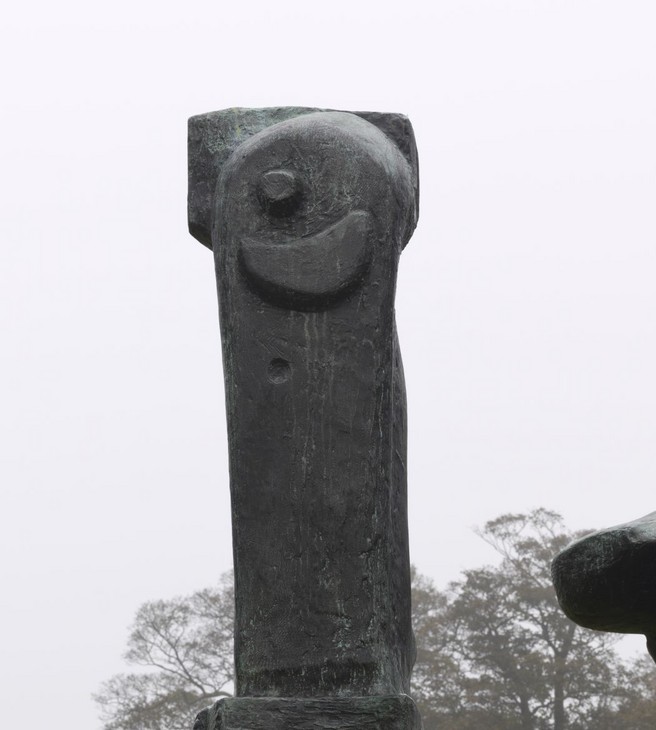
Detail of upper section of Upright Motive No.2 1955–6, cast c.1958–62
Tate T02275
© The Henry Moore Foundation. All Rights Reserved
Fig.3
Detail of upper section of Upright Motive No.2 1955–6, cast c.1958–62
Tate T02275
© The Henry Moore Foundation. All Rights Reserved
When the plaster was complete a mould was taken from it so that it could be cast in hollow bronze at the foundry. The maximum size of any one piece of cast bronze depends upon the size of the crucible at the foundry, as the molten bronze used to make the sculpture must be poured into the mould in one go. In practice this means that bronzes of this size are usually cast in sections, and then welded together. This sculpture was probably cast in at least three separate pieces, although the weld lines have been carefully disguised using a technique known as chasing. This involves filing down any excess metal from the weld and then texturing the surface with punch tools to match the surrounding bronze surface.

Detail showing green rainwater tracks on side of Upright Motive No.2 1955–6, cast c.1958–62
Tate T02275
© The Henry Moore Foundation. All Rights Reserved
Fig.4
Detail showing green rainwater tracks on side of Upright Motive No.2 1955–6, cast c.1958–62
Tate T02275
© The Henry Moore Foundation. All Rights Reserved
When the sculpture left the foundry it would have been given a coating of protective wax, which is replaced annually as part of an ongoing maintenance programme. This procedure involves washing the surface to remove dirt deposits and bird lime before the new wax is applied. A black wax has been used for its maintenance in the past, and this has both darkened the patina and left residues in the recesses of the sculpture.
The sculpture is not signed or numbered, and is fixed to a rectangular bronze base, most likely by bolts from underneath. The base was probably cast using the sand casting technique and then given a smooth finish by sanding the surface.1 Outdoor sculptures like this are usually fixed into a concrete foundation underneath the base to make them more stable.
Lyndsey Morgan
May 2013
Entry
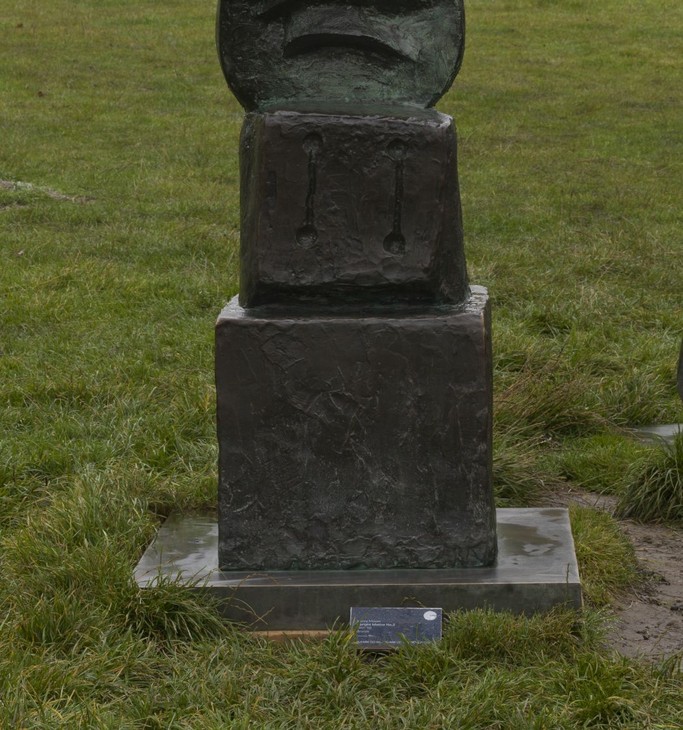
Detail of circle and line motif on Upright Motive No.2 1955–6, cast c.1958–62
Tate T02275
© The Henry Moore Foundation. All Rights Reserved
Fig.1
Detail of circle and line motif on Upright Motive No.2 1955–6, cast c.1958–62
Tate T02275
© The Henry Moore Foundation. All Rights Reserved
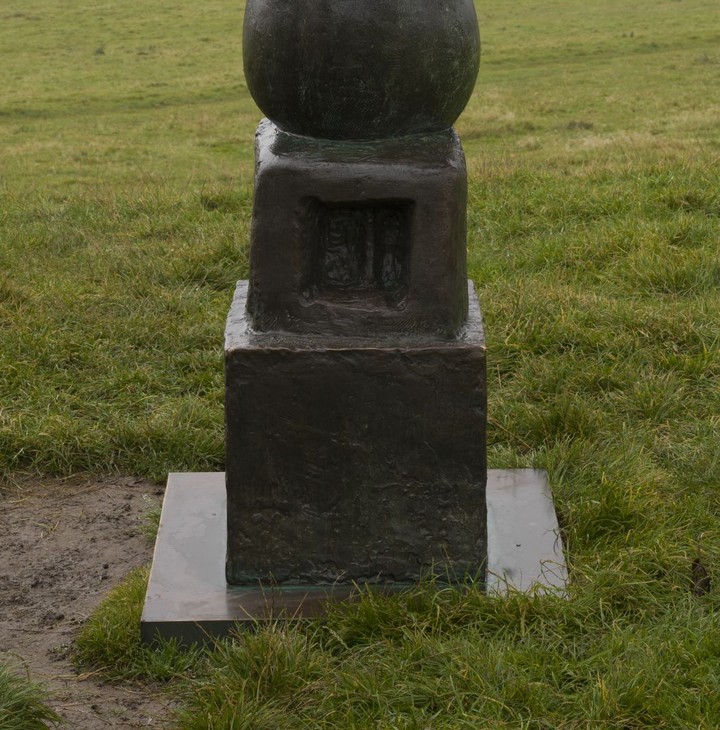
Detail of square-shaped cavity on Upright Motive No.2 1955–6, cast c.1958–62
Tate T02275
© The Henry Moore Foundation. All Rights Reserved
Fig.2
Detail of square-shaped cavity on Upright Motive No.2 1955–6, cast c.1958–62
Tate T02275
© The Henry Moore Foundation. All Rights Reserved
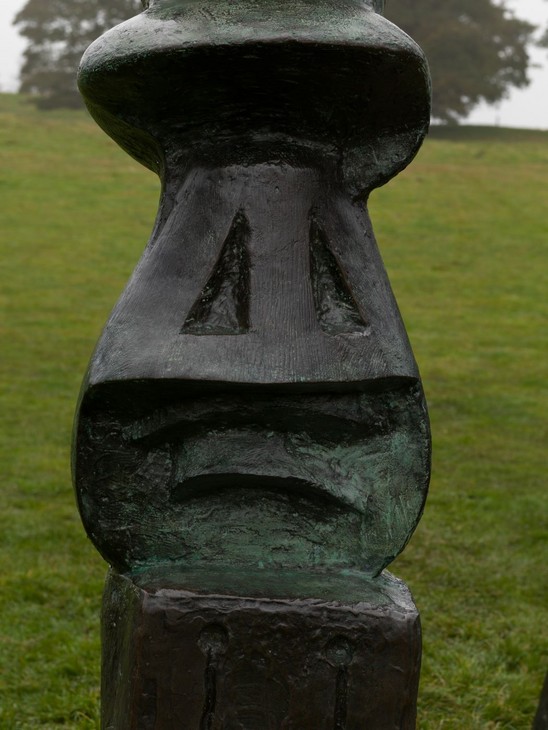
Henry Moore
Detail of pear-shaped form with triangles on Upright Motive No.2 1955–6, cast c.1958–62
Tate T02275
© The Henry Moore Foundation. All Rights Reserved
Fig.3
Henry Moore
Detail of pear-shaped form with triangles on Upright Motive No.2 1955–6, cast c.1958–62
Tate T02275
© The Henry Moore Foundation. All Rights Reserved
On top of this curved form is a rounded, disc-shaped protrusion, and a larger amorphous form that supports the upper section of the sculpture. The uppermost part of the sculpture has distinct sides: one features a rectangular relief with a round top edge that is adorned with a raised dome and half-moon shape (fig.4), while the other presents an arrangement of irregular bulbous forms (fig.5). These protrusions culminate in a conical projection with a domed impression at the apex.
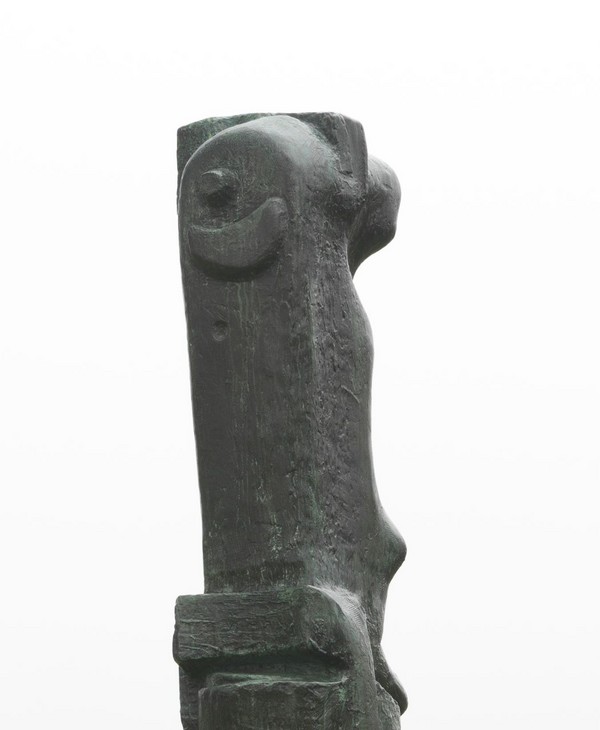
Detail of upper section of Upright Motive No.2 1955–6, cast c.1958–62
Tate T02275
© The Henry Moore Foundation. All Rights Reserved
Fig.4
Detail of upper section of Upright Motive No.2 1955–6, cast c.1958–62
Tate T02275
© The Henry Moore Foundation. All Rights Reserved
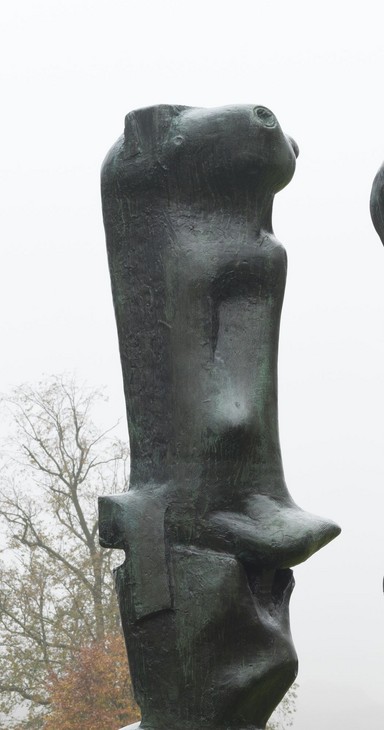
Detail of amorphous protrusions on the upper section of Upright Motive No.2 1955-6, cast c.1958-62
Tate T02275
© The Henry Moore Foundation. All Rights Reserved
Fig.5
Detail of amorphous protrusions on the upper section of Upright Motive No.2 1955-6, cast c.1958-62
Tate T02275
© The Henry Moore Foundation. All Rights Reserved
The sides of the sculpture do not have any specific markings. However, a vertical strip or bar can be seen on both flanks as if fixing the upper and lower sections of the sculpture together (fig.6). While it is unlikely that these features actually perform a practical function, they nonetheless contribute to the sense that different, sometimes disparate, elements have been artificially conjoined in this sculpture.
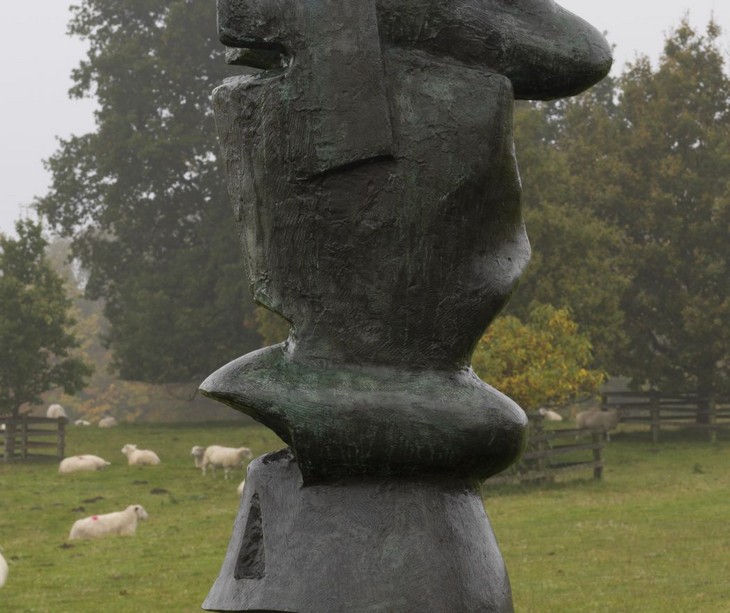
Henry Moore
Upright Motive No.21955-6, cast c.1958-62, detail showing different surface textures and patination
Tate T02275
© The Henry Moore Foundation. All Rights Reserved
Fig.7
Henry Moore
Upright Motive No.21955-6, cast c.1958-62, detail showing different surface textures and patination
Tate T02275
© The Henry Moore Foundation. All Rights Reserved
Making the Upright Motives
Upright Motive No.2 is one of a series of vertically-orientated sculptures known as ‘upright motives’ that Moore made between 1955 and 1956. Moore created thirteen small bronze maquettes for individual sculptures, of which five (numbers 1, 2, 5, 7 and 8) were enlarged to full size. In addition to Upright Motive No.2, Upright Motive No.1: Glenkiln Cross 1955–6, cast 1958–60 (Tate T02274) and Upright Motive No.7 1955–6, cast c.1958–61 (Tate T02276) are also held in the Tate collection. Discussing the series in 1968 Moore recalled:
The maquettes for this upright motif theme were triggered off for me by being asked by the architect to do a sculpture for the courtyard of the new Olivetti building in Milan. It is a very low horizontal one-storey building. My immediate thought was that any sculpture that I should do must be in contrast to this horizontal rhythm. It needed some vertical form in front of it. At the time I also wanted to have a change from the Reclining Figure theme that I had returned to so often. So I did all these small maquettes. They were never used for the Milan building in the end because, at a later stage, when I found that the sculpture would virtually be in a car park, I lost interest. I had no desire to have a sculpture where half of it would be obscured most of the day by cars. I do not think that cars and sculptures really go well together.1
The cataloguer of Moore’s drawings, Ann Garrould, has identified four individual pages of sketches depicting upright motives dating from 1954–6 (fig.8).2 Each of the sketches in Upright Motives 1954–6 share compositional elements with Upright Motive No.2; the upright motive on the far left, for example is made up of multiple forms stacked on top of each other, while the other forms have each been divided into two distinct sections – a structured column and a sequence of bulbous forms. However, it is unlikely that these drawings were preliminary sketches for specific sculptures. The curator Alan Wilkinson has asserted that ‘there were no preparatory drawings for these works’, and indeed by the mid-1950s – when he created the upright motive series – Moore rarely worked directly from studies on paper, preferring instead to begin each new project by making small three-dimensional models in plaster, clay or other malleable materials.3 In 1978 Moore described his working practice, remarking ‘I have gradually changed from using preliminary drawings for my sculptures to working from the beginning in three-dimensions. That is, I first make a maquette for any idea I have for a sculpture ... I can hold it in my hand, turning it over to look at it from above, underneath, and in fact from any angle’.4
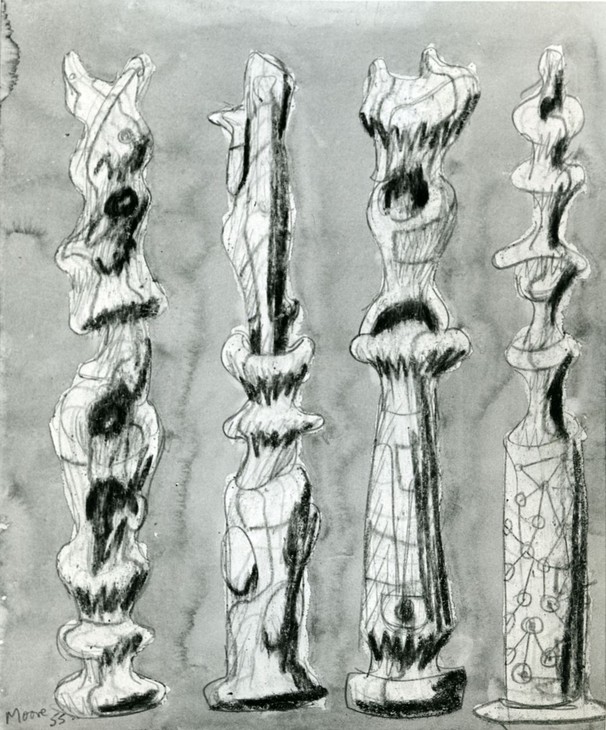
Henry Moore
Upright Motives 1954–6
Graphite, wax crayon, coloured crayon, pastel and watercolour wash on paper
289 x 238 mm
© The Henry Moore Foundation. All Rights Reserved
Photo: Henry Moore Foundation Archive
Fig.8
Henry Moore
Upright Motives 1954–6
© The Henry Moore Foundation. All Rights Reserved
Photo: Henry Moore Foundation Archive
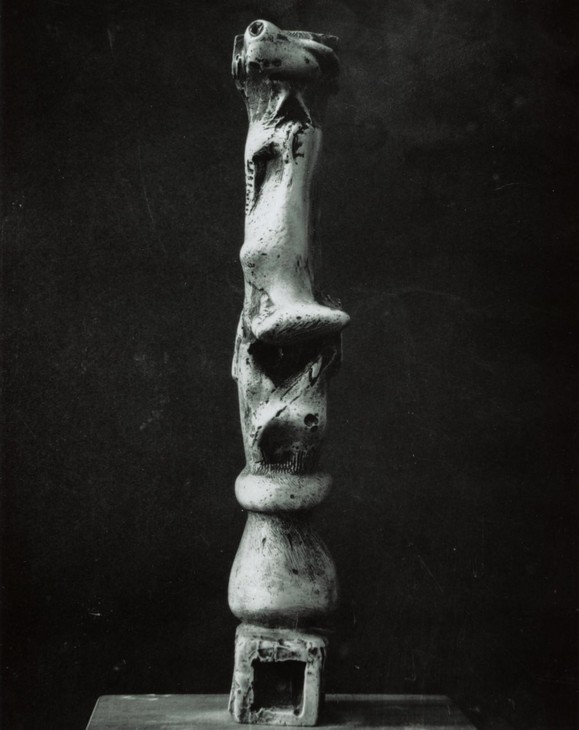
Henry Moore
Upright Motive: Maquette No.2 1955
Plaster
Whereabouts unknown
© The Henry Moore Foundation. All Rights Reserved
Photo: Henry Moore Foundation Archive
Fig.9
Henry Moore
Upright Motive: Maquette No.2 1955
Whereabouts unknown
© The Henry Moore Foundation. All Rights Reserved
Photo: Henry Moore Foundation Archive
It is probable that Moore made the plaster maquette for Upright Motive No.2 (fig.9) in his maquette studio in the grounds of his home, Hoglands, at Perry Green in Hertfordshire. Formerly the village shop, the building was used by Moore in the 1950s for creating small plaster sculptures and was lined with shelves on which his collection of bones, shells, and pebbles – what he called his ‘library of natural forms’ – was stored.5 Surrounded by these objects, Moore appropriated their shapes when creating his own sculptures. In 1963 he explained to the critic David Sylvester how he worked with found natural objects:
I look at them, handle them, see them from all round, and I may press then into clay and pour plaster into that clay and get a start as a bit of plaster, which is a reproduction of the object. And then add to it, change it. In that sort of way something turns out in the end that you could never have thought of the day before.6
In 1955 Moore was just beginning to develop the working technique he described confidently to Sylvester in 1963. It is likely that Upright Motive No.2 developed from pieces of plaster cast from the impressions left by stones pressed into clay or plasticine, which were placed alongside modelled shapes. Once these pieces of plaster had hardened, Moore could then add and subtract forms, and smooth or sharpen edges to make the final plaster maquette. Moore had intended to cast the plaster Upright Motive: Maquette No.2 in bronze but it went missing before the edition could be made.7
Once Moore was happy with the design of his maquette a full-size plaster version would have been made, probably with the help of one of his assistants, who at the time included Daryll Hill, Peter King, Lenton Parr and Stephen Walker. Moore was able to allocate the bulk of this preliminary work to others because, as the curator Julie Summers has noted, the enlargement process was ‘a scientific rather than artistic process’.8 The first stage in this process involved constructing an armature out of wood or wire netting using the smaller maquette as a guide. Over this structure layers of plaster would then be built up, and the sculpture would begin to gain mass and form.
When the full-size plaster version was near completion Moore would inspect it and finish the details on the surface before sending it to a professional bronze foundry for casting. It is unknown when exactly Tate’s sculpture was cast, but records held in the Henry Moore Foundation Archive reveal that the edition of Upright Motive No.2 was cast at H.H. Martyn in Cheltenham. Moore used this foundry between c.1958 and 1970, although he also employed a number of others in London, Paris and Berlin over the course of this period.9 At the foundry the technicians used the plaster original to create hollow moulds into which molten bronze could be poured. Due to its size it is likely that Upright Motive No.2 was cast in sections that were then welded together.
Upright Motive No.2 exists in an edition of five plus one artist’s copy. Given how expensive it was to cast these large bronze sculptures Moore rarely cast a whole edition at once, and Moore’s original plasters were usually retained by the foundry until all the casts in an edition had been made. Letters sent between Moore and G.W. Reid at H.H. Martyn reveal that the foundry was making casts of Upright Motive No.2 between 1958 and 1962.10 Tate’s sculpture is not signed or numbered but since it was given to the gallery as part of the Henry Moore Gift, it is likely to be the artist’s copy.
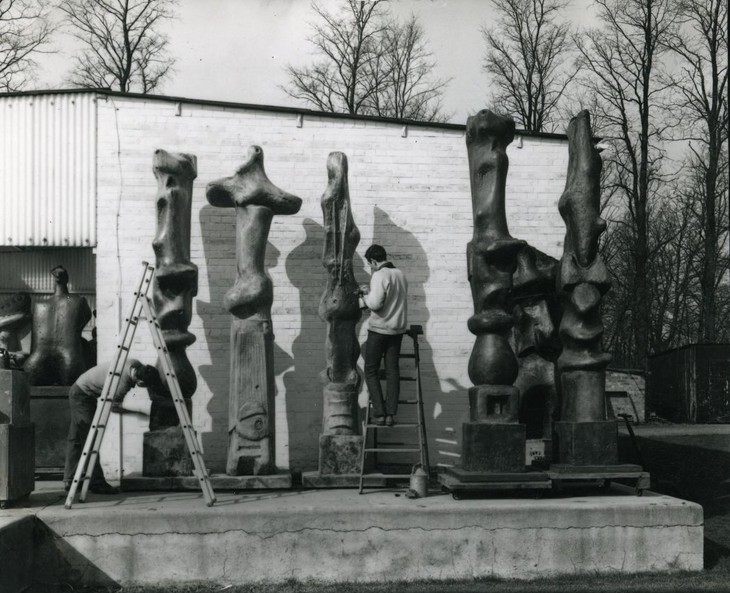
Moore's assistants patinating bronze sculptures from the upright motive series c.1958–60
© The Henry Moore Foundation. All Rights Reserved
Photo: John Hedgecoe
Fig.10
Moore's assistants patinating bronze sculptures from the upright motive series c.1958–60
© The Henry Moore Foundation. All Rights Reserved
Photo: John Hedgecoe
When the original plaster was retuned to Moore from the foundry it was placed outside in the grounds of Hoglands, where it slowly decayed over time and eventually toppled over. Moore first started working in plaster in the late 1940s, at which point these sculptures were regarded as steps in the casting process, and not of works of art in their own right. This explains why the plaster version of Upright Motive No.2 was allowed to collapse.
Sources and development
In his 1965 essay on Moore’s upright motives the critic John Russell sought to locate their origins in Moore’s earlier work.12 Although Moore was known chiefly for his horizontally-orientated reclining female figures such as Reclining Figure 1951 (Tate T02270), Russell demonstrated that Moore had also subjected the upright figure to consistent, albeit infrequent, examination throughout his career. From the early wood carving Torso 1927 (fig.11) and Stringed Figure of 1938 through to Three Standing Figures 1953 (fig.12), Russell provided a chronology of Moore’s vertical standing forms to which Upright Motive No.2 may be related.13 In the same year the critic Herbert Read concurred that Moore’s upright motives could ‘be regarded as a synthesis of significant forms that had been realised in the previous twenty years of the sculptor’s development’.14 Read identified Moore’s early interest in so-called ‘primitive’ art, his surrealist works of the 1930s, the impact of his visit to Greece in 1951, and the architectural commissions he undertook in the early 1950s as being instrumental to the formation of the upright motive series.
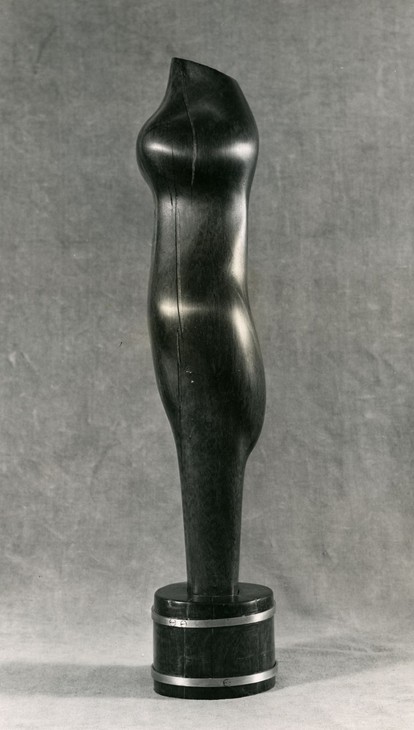
Henry Moore
Torso 1927
Wood
© The Henry Moore Foundation. All Rights Reserved
Photo: Henry Moore Foundation Archive
Fig.11
Henry Moore
Torso 1927
© The Henry Moore Foundation. All Rights Reserved
Photo: Henry Moore Foundation Archive
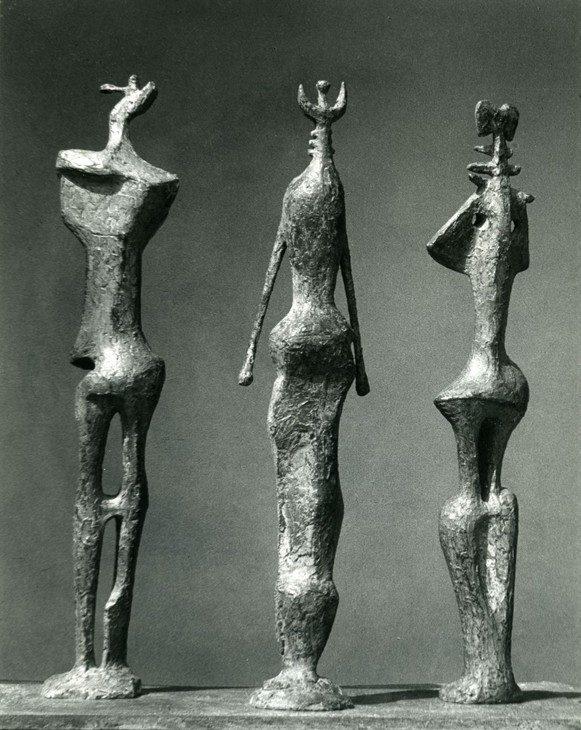
Henry Moore
Three Standing Figures 1953
Bronze
© The Henry Moore Foundation. All Rights Reserved
Photo: Henry Moore Foundation Archive
Fig.12
Henry Moore
Three Standing Figures 1953
© The Henry Moore Foundation. All Rights Reserved
Photo: Henry Moore Foundation Archive
‘Primitive art’ was an over-arching term used by artists and art historians in the first half of the twentieth century to describe examples of non-Western art – such as indigenous art from Africa, North America, Asia and the Pacific Islands – and ancient, prehistoric and medieval European art. Spanning geography and historical time, primitive art was deemed to be more expressive and authentic than the staid naturalistic conventions of European fine art made since the Renaissance. Moore himself identified that his upright motives showed a resemblance to examples of primitive art. In 1965, for example, the sculptor noted that he began work on his maquettes ‘by balancing different forms one above the other – with results rather like the North-West American totem poles’.15 Read proposed that prototypes for Moore’s standing totems could be found in the prehistoric standing stones of Stonehenge and Avebury Circle in south-west England and Carnac in Brittany, France.16 Moore first visited Stonehenge as a student in autumn 1921 and retained an interest in the Neolithic standing stones throughout his career. According to the art historian Andrew Causey, Moore revisited the site on more than one occasion in the 1950s ‘when his daughter, Mary, was at school nearby’.17 Moore’s interest in Stonehenge culminated in a series of lithographs depicting the standing stones made in 1972–3 (see Tate P02169– P02187).
Moore’s interest in Stonehenge was not unique and as the art historian Sam Smiles has outlined, by the 1930s a number of artists within Moore’s circle, including the painter Paul Nash and the sculptor Barbara Hepworth, had developed an appeal for the standing stones considering them to be examples of British primitive art.18 In a letter to Nash written on 15 September 1933 Moore responded to a query stating, ‘Yes. I’ve seen Stonehenge. Its [sic] very impressive. I’ve read somewhere that certain primitive peoples coming across a large block of stone in their wanderings would worship it as a god – which is easy to understand, for there’s a sense of immense power about a large rough-shaped lump of rock or stone’.19 In their essay examining Moore’s outdoor sculptures, art historians Penelope Curtis and Fiona Russell suggested that ‘by the later 1930s Moore and Hepworth were clearly ready to suggest that their own sculptures were monuments in a lineage of stone monuments of the Neolithic builders, with perhaps a similarly arcane or forgotten purpose. Their sculptures were at once ancient and modern, or, to use the title of Paul Nash’s painting, Equivalents for the Megaliths’ (see Tate T01251).20
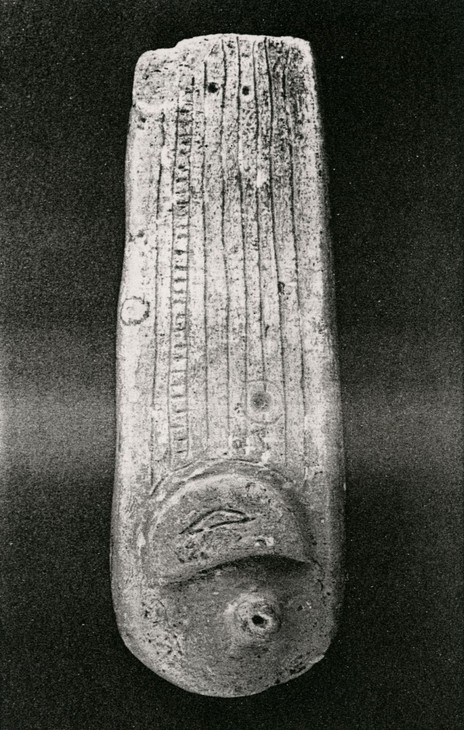
Henry Moore
Small Relief: Lower Half of 'Upright Motive: Maquette No.1' 1955
Terracotta
Art Gallery of Ontario, Toronto
© The Henry Moore Foundation. All rights reserved
Fig.13
Henry Moore
Small Relief: Lower Half of 'Upright Motive: Maquette No.1' 1955
Art Gallery of Ontario, Toronto
© The Henry Moore Foundation. All rights reserved
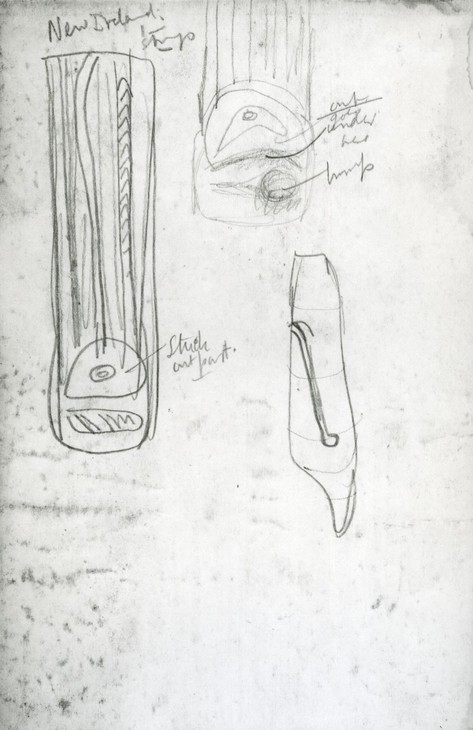
Henry Moore
Ideas for Sculpture c.1935
Graphite on paper
© The Henry Moore Foundation. All Rights Reserved
Fig.14
Henry Moore
Ideas for Sculpture c.1935
© The Henry Moore Foundation. All Rights Reserved
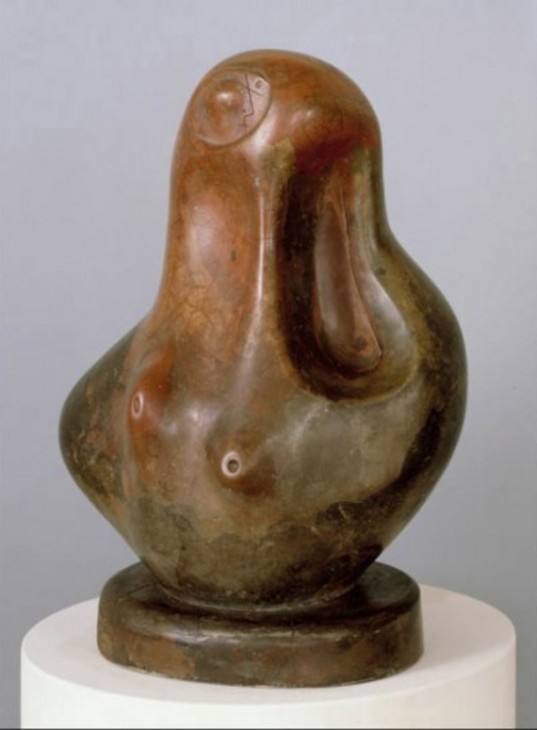
Henry Moore
Composition 1933
Concrete
British Council Collection
© The Henry Moore Foundation. All Rights Reserved
Fig.15
Henry Moore
Composition 1933
British Council Collection
© The Henry Moore Foundation. All Rights Reserved
Herbert Read also noted the extent to which Moore’s upright motives were indebted to his surrealist sculptures of the 1930s.24 The conical projection at the apex of Upright Motive No.2 may have its origins in Moore’s series of cyclopic forms such as Composition 1933 (fig.15), created, according to Read, during Moore’s most ‘surreal’ phase. The circular depression at its apex, around which a circular line has been incised, appears to bear a close relationship to the ‘eyes’ of sculptures like Composition, which are identifiable by a round point at the head of a growth emerging smoothly from the surface. Although Moore has been described by the art historian Michel Remy as an active member of a group of artists, writers and critics, including Nash, Read and Roland Penrose, who engaged with surrealist ideas and motifs during the decade, art historian David Nash has observed that ‘Moore approached Surrealism selectively’.25
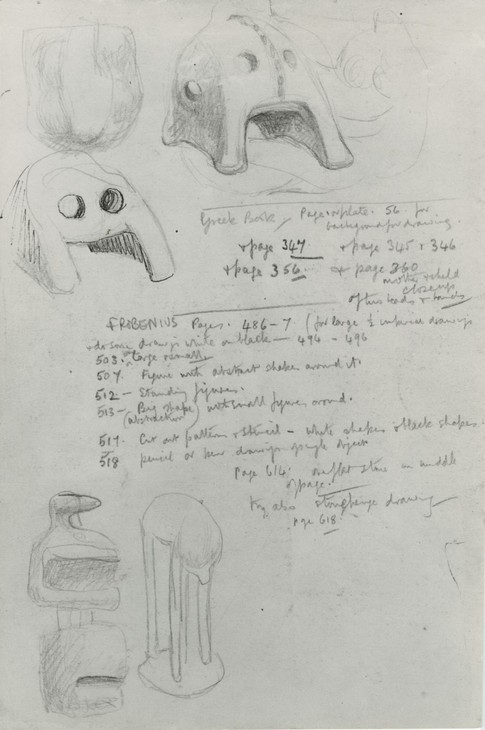
Henry Moore
Ideas for Sculpture and Artist's Notes 1937
Graphite, pen and ink and chalk on paper
272 x 184 mm
© The Henry Moore Foundation. All Rights Reserved
Photo: Henry Moore Foundation Archive
Fig.16
Henry Moore
Ideas for Sculpture and Artist's Notes 1937
© The Henry Moore Foundation. All Rights Reserved
Photo: Henry Moore Foundation Archive
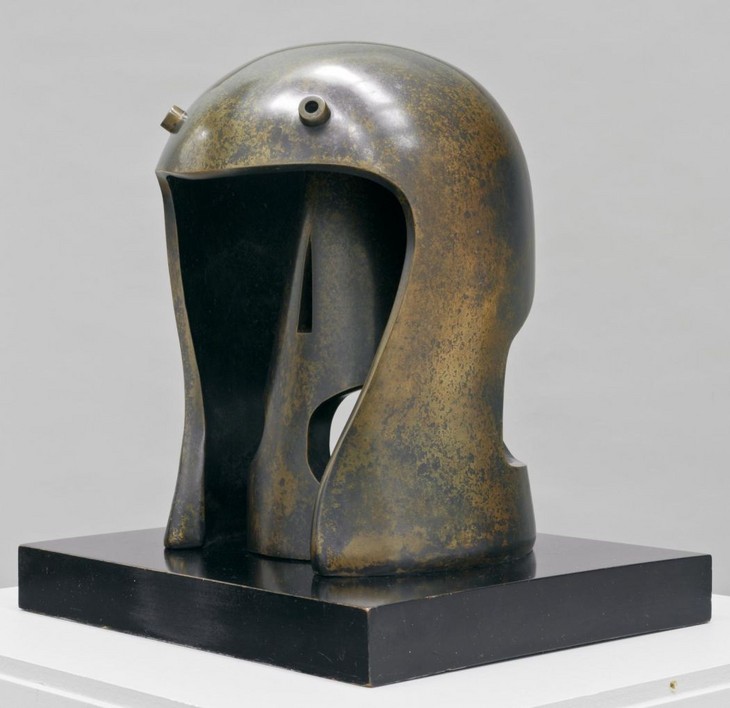
Henry Moore
Helmet Head No.1 1950, cast 1960
Tate T00388
Photo © The Henry Moore Foundation. All Rights Reserved
Fig.17
Henry Moore
Helmet Head No.1 1950, cast 1960
Tate T00388
Photo © The Henry Moore Foundation. All Rights Reserved
The loosely pear-shaped form with an angular indentation that is positioned towards the foot of Upright Motive No.2 can perhaps be traced to drawings Moore made of ancient Greek helmets in 1937 (fig.16) and to his series of ‘Helmet Head’ sculptures from the 1950s (fig.17). The rounded dome of Helmet Head No.1 1950, with its cut-away areas pre-dates the helmet-like section of Upright Motive No.2 with its smooth, rounded form into which is cut an almost right-angled recess.
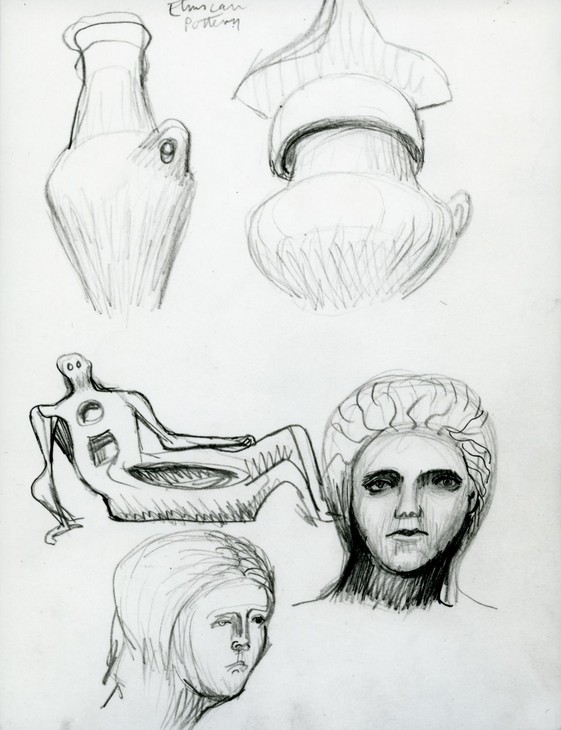
Henry Moore
Etruscan Pottery and Heads 1955–6
Graphite, pen and ink on paper
The Henry Moore Foundation
© The Henry Moore Foundation. All Rights Reserved
Photo: Henry Moore Foundation Archive
Fig.18
Henry Moore
Etruscan Pottery and Heads 1955–6
The Henry Moore Foundation
© The Henry Moore Foundation. All Rights Reserved
Photo: Henry Moore Foundation Archive
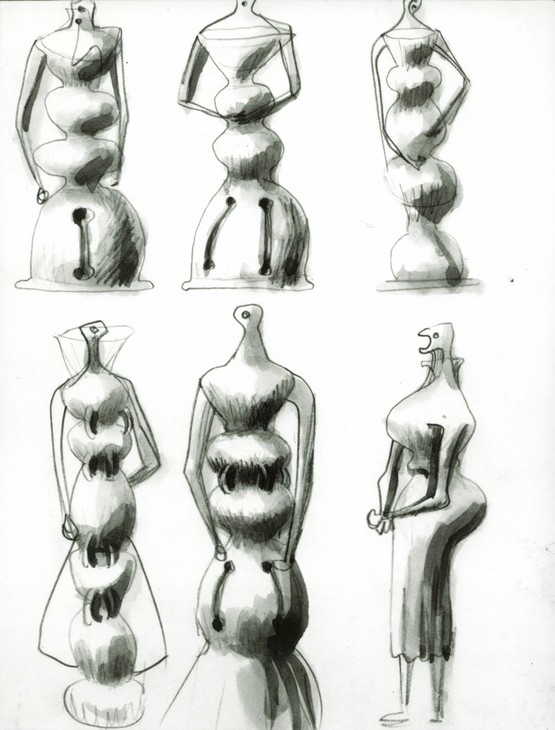
Henry Moore
Six Standing Forms 1955–56
Graphite, brush and ink on paper
The Henry Moore Foundation
© The Henry Moore Foundation. All Rights Reserved
Photo: Henry Moore Foundation Archive
Fig.19
Henry Moore
Six Standing Forms 1955–56
The Henry Moore Foundation
© The Henry Moore Foundation. All Rights Reserved
Photo: Henry Moore Foundation Archive
In addition to Moore’s evident interest in ancient Greek helmets, Upright Motive No.2, and indeed the upright motive series, may be regarded as the culmination of a sequence of formal developments made after Moore’s first and only trip to Greece in 1951. Following his trip Moore made a drawing of two vases, annotated with the phrase ‘Etruscan Pottery’ (fig.18). At the sketches present two different types of vase; on the left is an elongated form, suggestive of Greek neck-amphorae: tall ceramic pots with distinctive handles and a thin tubular neck,26 while the vase on the right is a vertical arrangement of interlocking parts. The same sketchbook contains other drawings in which Moore appears to have developed the vases into a series of segmented female figures (fig.19). As well as sharing a comparable stacked arrangement, the drawings of female figures and Upright Motive No.2 also feature the same motif of circles connected by vertical lines. Although Moore did not sign or date these sketches they have been retrospectively dated 1955–6. However, the cataloguer of Moore’s drawings, Ann Garrould, noted that the other contents of the notebook in which these sketches were made indicates that ‘the notebook was started well before 1955’.27 This in turn supports Garrould’s argument that these sketches also influenced the design of Moore’s Bird Table, which was made in 1954.28
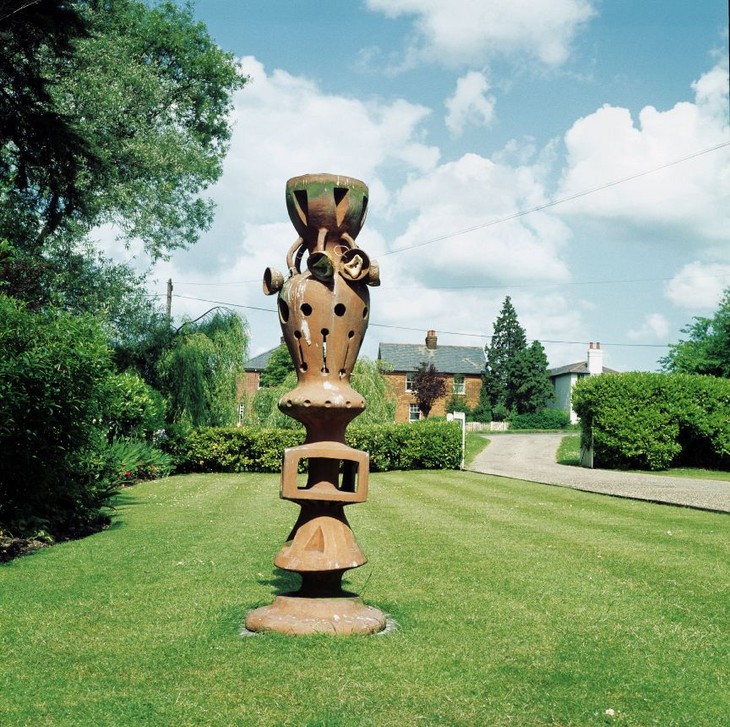
Henry Moore
Bird Table 1954, in the garden at Hoglands
Terracotta
The Henry Moore Foundation
© The Henry Moore Foundation. All Rights Reserved
Photo: Henry Moore Foundation Archive
Fig.20
Henry Moore
Bird Table 1954, in the garden at Hoglands
The Henry Moore Foundation
© The Henry Moore Foundation. All Rights Reserved
Photo: Henry Moore Foundation Archive
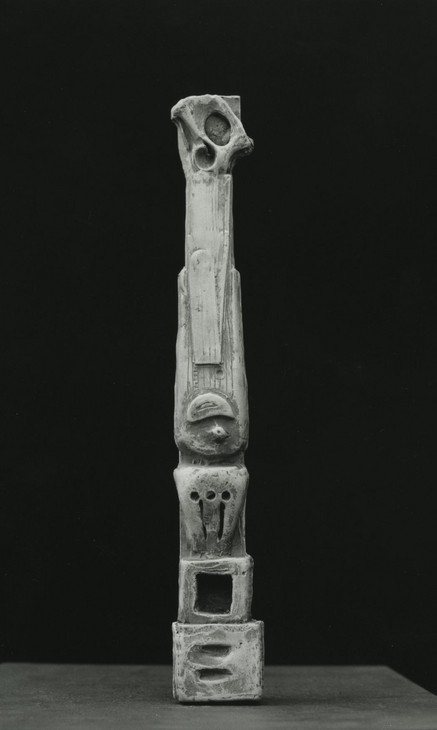
Henry Moore
Upright Motive Relief: Maquette No.2 c.1954
Plaster
Leeds City Art Gallery
© The Henry Moore Foundation. All Rights Reserved
Fig.21
Henry Moore
Upright Motive Relief: Maquette No.2 c.1954
Leeds City Art Gallery
© The Henry Moore Foundation. All Rights Reserved
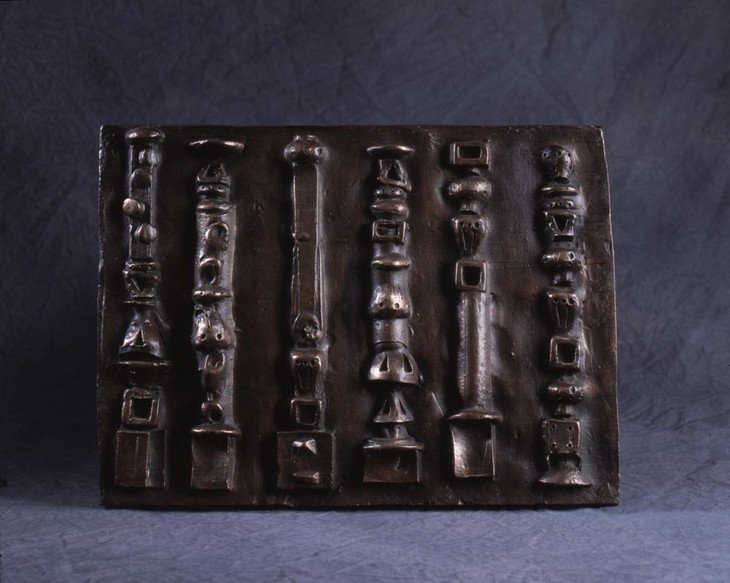
Henry Moore
Wall Relief: Maquette No.2 1955
Bronze
180 x 337 mm
The Henry Moore Foundation
© The Henry Moore Foundation. All Rights Reserved
Photo: Darren Chung, Henry Moore Foundation Archive
Fig.22
Henry Moore
Wall Relief: Maquette No.2 1955
The Henry Moore Foundation
© The Henry Moore Foundation. All Rights Reserved
Photo: Darren Chung, Henry Moore Foundation Archive
The final work for the Bouwcentrum in Rotterdam was constructed in brick and comprised rounded, organic shapes framed by vertical striations on both sides and geometric blocks above and below. According to John Russell, Moore’s relief works were, ‘abstract arrangements that had a formal life of their own: a vigorous, chunky, all-purpose vitality that seemed to burst out of the columnar structure and set off all manner of associations. They were not so much reliefs as free-standing sculptures that seemed to have sunk into the body of the wall’.35 Following a discussion with Moore on 12 December 1980, Tate curator Richard Morphet reported that the Bouwcentrum commission ‘led to the idea of releasing the forms from their incorporation in the fabric of the wall so that they become free-standing’.36
Grouping the Upright Motives
Tate’s cast of Upright Motive No.2 was first exhibited in Moore’s solo exhibition at the Whitechapel Gallery, London, in 1960 where it was displayed in a grouping alongside Upright Motive No.1: Glenkiln Cross and Upright Motive No.7. Although each of the upright motives were conceived as individual artworks, Moore later suggested that the idea of presenting numbers one, two and seven together had come to him at an early stage in their development. In 1965 Moore claimed that ‘when I came to carry out some of these maquettes in their final full size, three of them grouped themselves together’. 37

Upright Motive No.7 1955–6, cast c.1958–61, Upright Motive No.1: Glenkiln Cross 1955–6, cast 1958–60, and Upright Motive No.2 1955–6, cast c.1958–62 installed at the Rijksmuseum Kröller-Müller in Otterlo, 1965
© The Henry Moore Foundation. All Rights Reserved
Photo: Henry Moore Foundation Archive
Fig.23
Upright Motive No.7 1955–6, cast c.1958–61, Upright Motive No.1: Glenkiln Cross 1955–6, cast 1958–60, and Upright Motive No.2 1955–6, cast c.1958–62 installed at the Rijksmuseum Kröller-Müller in Otterlo, 1965
© The Henry Moore Foundation. All Rights Reserved
Photo: Henry Moore Foundation Archive
Moore’s sculptures may also be understood in relation to the presentation of religious themes and subjects by other artists working at the time. In 1965 a critic writing in the Burlington Magazine observed that Moore’s upright motives were created ‘at roughly the same time as Graham Sutherland was experimenting with the same type of figure in his paintings’.43 However, it was not until 1998 that this reference to the British painter Sutherland was explored further. In her book New Art / New World: British Art in Postwar Society the art historian Margaret Garlake compared Moore’s upright motives with contemporaneous works by Sutherland, remarking that the triptych of sculptures produced ‘a set of variations on natural forms that were congruent with Christian imagery in a manner comprable to Sutherland’s standing forms’.44 For example, in paintings such as Standing Forms II 1952 (fig.24), Sutherland depicted three vertical forms comprised of interlocking organic shapes, some of which are positioned on plinths. These associations are strengthened by the fact that Moore knew Sutherland’s work well. Not only was he present at the unveiling of Sutherland’s Crucifixion 1946 at St Matthew’s Church in Northampton (which had also commissioned Moore’s Madonna and Child 1943–4), but he also exhibited alongside Sutherland in the British Pavilion at the 1952 Venice Biennale.
The Henry Moore Gift
Henry Moore presented Upright Motive No.2 to the Tate Gallery in 1978 as part of the Henry Moore Gift. The Gift comprised thirty-six sculptures in bronze, marble and plaster and was exhibited in its entirety alongside Tate’s existing collection of Moore’s work in an exhibition celebrating the artist’s eightieth birthday, which opened in June 1978. A press release was duly prepared announcing that ‘The group [of sculptures] is the most substantial gift of works ever given to the Tate by an artist during his lifetime’.45 Upright Motive No.2 was displayed next to Upright Motive No.1: Glenkiln Cross and Upright Motive No.7 in the Duveen Galleries during the exhibition, and photographs taken while they were on display indicate that the three sculptures all had different patinas (fig.25). The exhibition was attended by over 20,500 people and nearly 11,000 copies of the catalogue were sold.46 At the close of the exhibition in late August 1978 the Director of Tate Norman Reid reflected in a letter to Moore’s daughter that although he was sad to see the exhibition come to an end ‘we have the consolation of the splendid group of sculptures which Henry has presented to the nation’.47
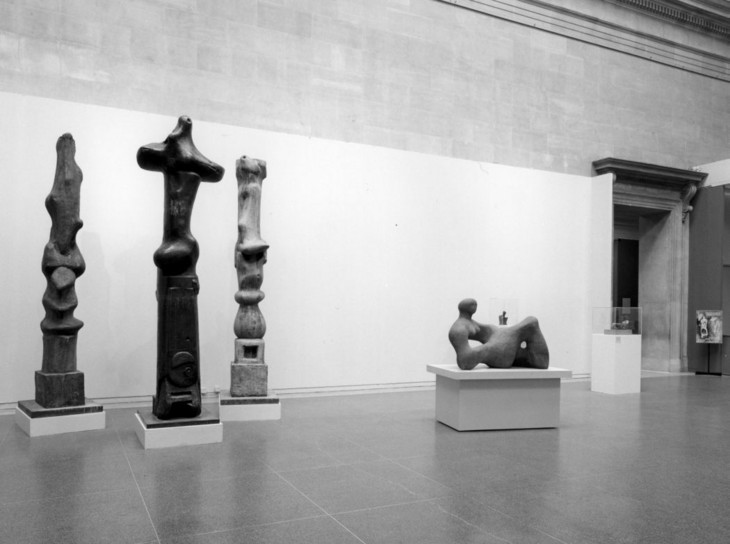
Upright Motive No.7, Upright Motive No.1: Glenkiln Cross and Upright Motive No.2 on display in the Duveen Galleries, Tate Gallery, London, 1978
Tate Archives
© The Henry Moore Foundation. All Rights Reserved
Fig.25
Upright Motive No.7, Upright Motive No.1: Glenkiln Cross and Upright Motive No.2 on display in the Duveen Galleries, Tate Gallery, London, 1978
Tate Archives
© The Henry Moore Foundation. All Rights Reserved
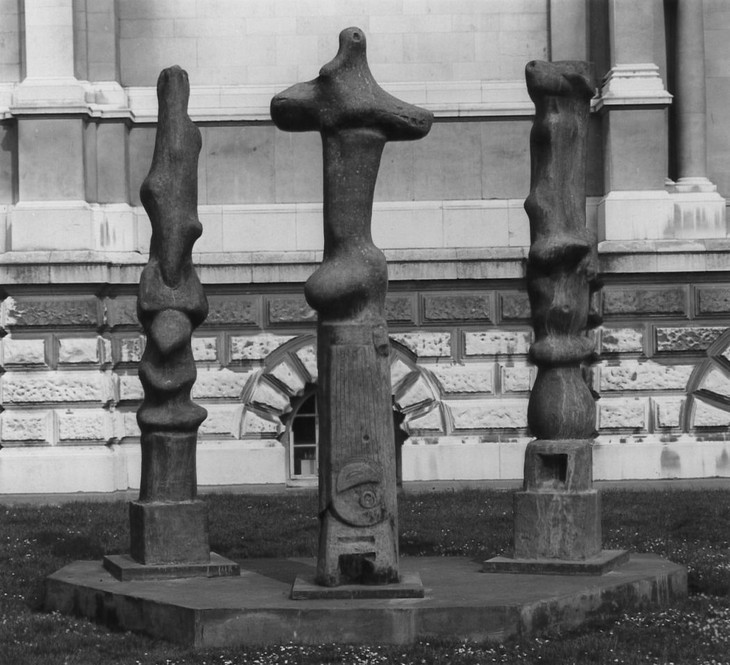
Upright Motive No.7, Upright Motive No.1: Glenkiln Cross and Upright Motive No.2 installed on the front lawn, Tate Gallery, London
Tate Archive
© The Henry Moore Foundation. All Rights Reserved
Fig.26
Upright Motive No.7, Upright Motive No.1: Glenkiln Cross and Upright Motive No.2 installed on the front lawn, Tate Gallery, London
Tate Archive
© The Henry Moore Foundation. All Rights Reserved
Following the exhibition the three upright motive sculptures were returned to Moore. In a letter to Moore’s secretary Betty Tinsley dated 25 July 1978, Ruth Rattenbury, Assistant Keeper of the Collection, itemised a number of works to be returned to the artist for repairs, and of the three upright motives noted that, ‘Mr Moore said that he would have them treated so that they were all the same colour’.48 In May 1979 the sculptures were returned to Tate and installed on a specially designed base on the lawn in front of the gallery. It is evident from the photographs taken of the installation at the time that the sculptures no longer displayed the variations in colour as they had previously (fig.26).
All three Upright Motive sculptures in the Tate Collection remained on display on the Tate lawn until April 1983 when they were relocated to the nearby Battersea Park. Apart from being removed temporarily for display at the Royal Academy of Arts and at Tate in 1988 and 1992 respectively, the sculptures remained in the park until October 1994. At that time, the decision was made to permanently remove all three of the upright motives after Upright Motive No.2 was forcefully rocked by vandals until it fell over. On inspecting the damage it was noted by Tate conservators that the sculpture had also been marked with graffiti (fig.27). After its restoration Upright Motive No.2 was placed on long-term loan to the Yorkshire Sculpture Park in Wakefield along with Upright Motive No.1: Glenkiln Cross and Upright Motive No.7 (fig.28), although they were returned to Tate in 2003 and exhibited in the Turbine Hall at Tate Modern for the display Henry Moore: Public Sculptures.
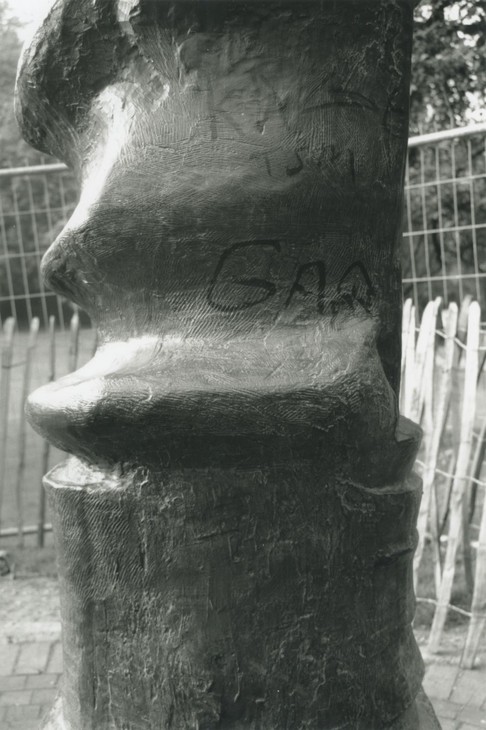
Detail of graffiti on Upright Motive No.2 1955–6, cast c.1958–62, in 1994
Tate Archive
© The Henry Moore Foundation. All Rights Reserved
Fig.27
Detail of graffiti on Upright Motive No.2 1955–6, cast c.1958–62, in 1994
Tate Archive
© The Henry Moore Foundation. All Rights Reserved

Upright Motive No.7 1955–6, cast c.1958–61, Upright Motive No.1: Glenkiln Cross 1955–6, cast 1958–60, and Upright Motive No.2 1955–6, cast c.1958–62 installed at Yorkshire Sculpture Park, November 2013
© The Henry Moore Foundation. All Rights Reserved
Fig.28
Upright Motive No.7 1955–6, cast c.1958–61, Upright Motive No.1: Glenkiln Cross 1955–6, cast 1958–60, and Upright Motive No.2 1955–6, cast c.1958–62 installed at Yorkshire Sculpture Park, November 2013
© The Henry Moore Foundation. All Rights Reserved

Upright Motive No.2 1955–6, cast c.1958–62, on display in the water garden, Harlow
© The Henry Moore Foundation. All Rights Reserved
Fig.29
Upright Motive No.2 1955–6, cast c.1958–62, on display in the water garden, Harlow
© The Henry Moore Foundation. All Rights Reserved
Alice Correia
March 2013
Notes
Alan G. Wilkinson, Henry Moore Remembered: The Collection at the Art Gallery of Ontario in Toronto, Toronto 1987, p.160.
Henry Moore in ‘Henry Moore Talking to David Sylvester’, 7 June 1963, transcript of Third Programme, broadcast BBC Radio, 14 July 1963, Tate Archive TGA 200816, p.18. (An edited version of this interview was published in the Listener, 29 August 1963, pp.305–7.)
Julie Summers, ‘Fragment of Maquette for King and Queen’, in Claude Allemand-Cosneau, Manfred Fath and David Mitchinson (eds.), Henry Moore From the Inside Out: Plasters, Carvings and Drawings, Munich 1996, p.126.
John Russell in Henry Moore, John Russell and A. M. Hammacher, Drie Staande Motieven, Otterlo 1965, unpaginated.
See Sam Smiles, ‘Equivalents for the Megaliths: Prehistory and English Culture, 1920–50’, in David Peters Corbett, Ysanne Holt and Fiona Russell (eds.), The Geographies of Englishness: Landscape and the National Past 1880–1940, New Haven 2002, pp.199–223.
Penelope Curtis and Fiona Russell, ‘Henry Moore and the Post-War British Landscape: Monuments Ancient and Modern’, in Jane Beckett and Fiona Russell (eds.), Henry Moore: Critical Essays, Aldershot 2003, p.138.
Moore’s niece, Ann Garrould, who catalogued Moore’s drawings, deciphered Moore’s hand written note as ‘New Ireland | stump’, while the art historian Christa Lichtenstern has read it as ‘New Ireland | string’. See Ann Garrould (ed.), Henry Moore. Volume 2: Complete Drawings 1930–39, London 1998, p.154, and Christa Lichtenstern, Henry Moore: Work-Theory-Impact, London 2008, p.205.
Anon., ‘Acquisitions of Works of Art by Museums and Galleries: Supplement’, Burlington Magazine, vol.107, no.747, June 1965, p.338.
David Nash, ‘Moore and Surrealism Reconsidered’, in Dorothy Kosinski (ed.),Henry Moore: Sculpting the 20th Century, exhibition catalogue, Dallas Museum ofArt, Dallas 2001, p.50. See also Michel Remy, Surrealism in Britain, Aldershot 1999.
See, for example, http://www.metmuseum.org/toah/works-of-art/10.210.7 , accessed 18 February 2014.
Mary Moore, ‘Catalogue’, in Gregor Muir (ed.), Henry Moore: Ideas for Sculpture, exhibition catalogue, Hauser & Wirth, London 2010, p.154.
Henry Moore, ‘Sculpture in the Open Air: A Talk by Henry Moore on his Sculpture and its Placing in Open-Air Sites’, March 1955, transcript ed. by Robert Melville, Tate Artist Catalogue File, Henry Moore, A23941, reprinted in Philip James (ed.), Henry Moore on Sculpture, London 1966, p.97.
Peyton Skipwith, ‘Catalogue’, in Henry Moore and Michael Rosenauer, exhibition catalogue, Fine Art Society, London 1988, unpaginated.
Anita Feldman Bennet, ‘Rediscovering Humanism’, in Henry Moore: In the Light of Greece, exhibition catalogue, Basil and Elise Goulandris Foundation Museum of Contemporary Art, Andros 2000, p.69.
[Richard Calvocoressi], ‘T.2281, Three Motives Against Wall No.2’, The Tate Gallery 1978–80: Illustrated Catalogue of Acquisitions, London 1981, p.126.
Anon., ‘Acquisitions of Works of Art by Museums and Galleries: Supplement’, Burlington Magazine, vol.107, no.747, June 1965, p.338.
Margaret Garlake, New Art / New World: British Art in Postwar Society, New Haven and London 1998, p.191.
Related essays
- Scale at Any Size: Henry Moore and Scaling Up Rachel Wells
- Henry Moore: The Plasters Anita Feldman
- Henry Moore and World Sculpture Dawn Ades
- Henry Moore's Approach to Bronze Lyndsey Morgan and Rozemarijn van der Molen
Related catalogue entries
Related material
-
Photograph
-
Photograph
How to cite
Alice Correia, ‘Upright Motive No.2 1955–6, cast c.1958–62 by Henry Moore OM, CH’, catalogue entry, March 2013, in Henry Moore: Sculptural Process and Public Identity, Tate Research Publication, 2015, https://www

